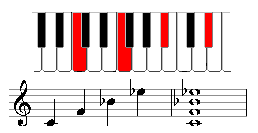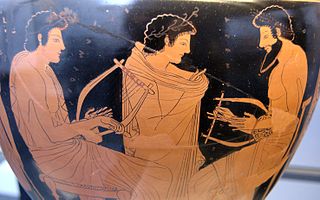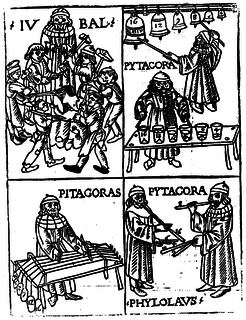
In music, harmony considers the process by which the composition of individual sounds, or superpositions of sounds, is analysed by hearing. Usually, this means simultaneously occurring frequencies, pitches, or chords.
In music theory, a leading-note is a note or pitch which resolves or "leads" to a note one semitone higher or lower, being a lower and upper leading-tone, respectively. Typically, the leading tone refers to the seventh scale degree of a major scale, a major seventh above the tonic.
An altered chord is a chord in which one or more notes from the diatonic scale is replaced with a neighboring pitch from the chromatic scale. According to the broadest definition any chord with a nondiatonic chord tone is an altered chord, while the simplest use of altered chords is the use of borrowed chords, chords borrowed from the parallel key, and the most common is the use of secondary dominants. As Alfred Blatter explains,"An altered chord occurs when one of the standard, functional chords is given another quality by the modification of one or more components of the chord."
This page is an alphabetized index of articles about music.
A nonchord tone (NCT), nonharmonic tone, or embellishing tone is a note in a piece of music or song that is not part of the implied or expressed chord set out by the harmonic framework. In contrast, a chord tone is a note that is a part of the functional chord. Nonchord tones are most often discussed in the context of the common practice period of classical music, but they can be used in the analysis of other types of tonal music as well, such as Western popular music.
A tone cluster is a musical chord comprising at least three adjacent tones in a scale. Prototypical tone clusters are based on the chromatic scale and are separated by semitones. For instance, three adjacent piano keys struck simultaneously produce a tone cluster. Variants of the tone cluster include chords comprising adjacent tones separated diatonically, pentatonically, or microtonally. On the piano, such clusters often involve the simultaneous striking of neighboring white or black keys.

In music theory, tertian describes any piece, chord, counterpoint etc. constructed from the intervals of thirds. An interval such as that between the notes A and C encompasses 3 semitone intervals and is termed a minor third while one such as that between C and E encompasses 4 semitones and is called a major third. Tertian harmony principally uses chords based on thirds; the term is typically used to contrast with quartal and quintal harmony which uses chords based on fourths or fifths.

In music or music theory, a thirteenth is the interval between the sixth and first scale degrees when the sixth is transposed up an octave, creating a compound sixth, or thirteenth. The thirteenth is most commonly major Play (help·info) or minor Play (help·info).
In music theory, a ninth chord is a chord that encompasses the interval of a ninth when arranged in close position with the root in the bass.

In music and music theory, a bichord or polychord consists of two or more chords, one on top of the other. In shorthand they are written with the top chord above a line and the bottom chord below, for example F upon C: F/C.

Pandiatonicism is a musical technique of using the diatonic scale without the limitations of functional tonality. Music using this technique is pandiatonic. The term "pandiatonicism" was coined by Nicolas Slonimsky in the second edition of Music since 1900 to describe chord formations of any number up to all seven degrees of the diatonic scale, "used freely in democratic equality". Triads with added notes such as the sixth, seventh, or second are the most common, while the, "most elementary form," is a nonharmonic bass. According to Slonimsky's definition,
Pan-diatonicism sanctions the simultaneous use of any or all seven tones of the diatonic scale, with the bass determining the harmony. The chord-building remains tertian, with the seventh, ninth, or thirteenth chords being treated as consonances functionally equivalent to the fundamental triad. Pan-diatonicism, as consolidation of tonality, is the favorite technique of NEO-CLASSICISM [sic].

In music, quartal harmony is the building of harmonic structures with a distinct preference for the intervals of the perfect fourth, the augmented fourth and the diminished fourth. Quintal harmony is harmonic structure preferring the perfect fifth, the augmented fifth and the diminished fifth.

In music, especially modern popular music a slash chord or slashed chord, also compound chord, is a chord whose bass note or inversion is indicated by the addition of a slash and the letter of the bass note after the root note letter. It does not indicate "or".
For example, a C major chord (C) in second inversion is written C/G or C/G bass, which reads "C slash G", "C over G" or "C over a G bass". If E were the bass it would be written C/E or C/E bass, which is read "C slash E", "C over E" or C/E bass. Some chords may not otherwise be notated, such as A♭/A. Thus, a slash chord may also indicate the chord form or shape and an additional bass note.
The Petrushka chord is a recurring polytonal device used in Igor Stravinsky's ballet Petrushka and in later music. These two major triads, C major and F♯ major – a tritone apart – clash, "horribly with each other", when sounded together and create a dissonant chord.

Diatonic and chromatic are terms in music theory that are most often used to characterize scales, and are also applied to musical instruments, intervals, chords, notes, musical styles, and kinds of harmony. They are very often used as a pair, especially when applied to contrasting features of the common practice music of the period 1600–1900.

The Elektra chord is a "complexly dissonant signature-chord" and motivic elaboration used by composer Richard Strauss to represent the title character of his opera Elektra that is a "bitonal synthesis of E major and C-sharp major" and may be regarded as a polychord related to conventional chords with added thirds, in this case an eleventh chord. It is enharmonically equivalent to a 7#9 chord : D♭-F-A♭-C♭-E.
Richard Dean Grove was an American musician, composer, arranger, and educator. He is best known as the founder of the Dick Grove School of Music. Its students include Michael Jackson, Linda Ronstadt, and Barry Manilow, and its teachers Henry Mancini, Bill Conti, and Lalo Schifrin.

Musicology commonly classifies scales as either hemitonic or anhemitonic. Hemitonic scales contain one or more semitones, while anhemitonic scales do not contain semitones. For example, in traditional Japanese music, the anhemitonic yo scale is contrasted with the hemitonic in scale. The simplest and most commonly used scale in the world is the atritonic anhemitonic "major" pentatonic scale. The whole tone scale is also anhemitonic.
A chordioid, also called chord fragment or fragmentary voicing or partial voicing, is a group of musical notes which does not qualify as a chord under some preferred chord theory or other, but still useful to name and reify for other reasons.
















